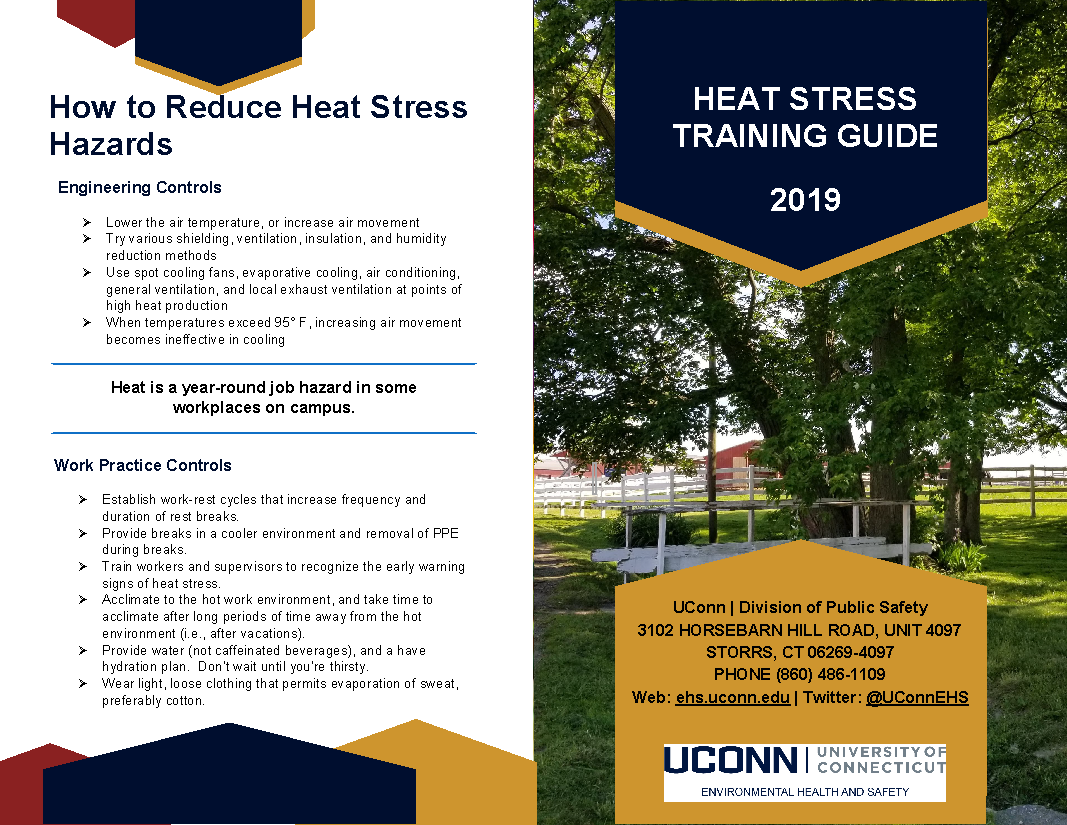

Heat Stress Training Guide 2019
How to Reduce Heat Stress Hazards
Engineering Controls
- Lower the air temperature, or increase air movement
- Try various shielding, ventilation, insulation, and humidity reduction methods
- Use spot cooling fans, evaporative cooling, air conditioning, general ventilation, and local exhaust ventilation at points of high heat production
- When temperatures exceed 95° F, increasing air movement becomes ineffective in cooling
Work Practice Controls
- Establish work-rest cycles that increase frequency and duration of rest breaks.
- Provide breaks in a cooler environment and removal of PPE during breaks.
- Train workers and supervisors to recognize the early warning signs of heat stress.
- Acclimate to the hot work environment, and take time to acclimate after long periods of time away from the hot environment (i.e., after vacations).
- Provide water (not caffeinated beverages), and a have hydration plan. Don’t wait until you’re thirsty.
- Wear light, loose clothing that permits evaporation of sweat, preferably cotton.
Heat as a Job Hazard
Heat is a year-round job hazard in some workplaces on campus. During summer months, employees have a greater risk of experiencing heat related illnesses. When a person works in a hot environment, the body must get rid of excess heat to maintain a stable internal temperature. It does this mainly through circulating blood to the skin, and by sweating.
When the air temperature is close to (or warmer than) normal body temperature, blood circulated to the skin cannot lose its heat. Sweating then becomes the main way the body cools off, but sweating is only effective if the humidity level is low enough to allow for evaporation and if the lost fluids and salts are replaced. If the body cannot get rid of excess heat, it will store it. When this happens the body’s core temperature rises and the heart and breathing rates increase. When heat gain exceeds heat loss, symptoms of heat strain (the physiological response to heat stress) can develop. There is no specific standard or temperature for identification of heat stress.
Symptoms of Heat Exhaustion:
• Heat rash
• Heavy sweating
• Headache
• Cramps
• Nausea/vomiting
• Intense thirst
• Rapid pulse
• Fatigue and weakness
Action: Move employee to cool environment, take steps to initiate cooling, provide fluids and allow to rest.
Symptoms of Heat Stroke: A true medical emergency:
• High body temperature
• Lack of sweating – hot, red, dry skin
• Rapid pulse
• Chills
• Difficulty breathing
• Disorientation, erratic behavior
• Fainting/collapse
• Convulsions
Action: Contact 911 immediately and take steps to cool the victim!
Heat Safety Facts
- The human body functions best within an internal temperature range of 98.6-100.4° F.
- The body has a natural ability to increase tolerance to heat stress through acclimation. Bodies are then able to sweat more and increase their cooling capability.
- How a person responds to heat stress is variable and dependent upon age, overall health, weight, medications, dehydration, and activities.
Additional Resource:
This NIOSH document covers establishing work/rest schedules (https://www.cdc.gov/niosh/mining/UserFiles/works/pdfs/2017-127.pdf) to help decrease the risk of heat-related illness. It takes into consideration temperature, sunlight, humidity, and work intensity.
As the summer advances, be aware of the signs of heat strain, for yourself and your fellow co-workers. Follow recommended engineering and work practice controls. Report any concerns to your management or EHS.